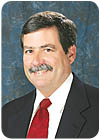
Dave Smith is vice president of marketing at Pelco, a video surveillance manufacturer.
SDM: What is driving customers’ interest in integrating video surveillance with other security systems such as access control?
SMITH: People want more seamless interconnection between access and video. Access has always been tightly integrated, and video can be such an asset to an access control system. For example, having the ability to not just accept a credential, but to visually verify who and how many people actually are using the credential is a very valid application.
SDM: What is entailed when security dealers want to integrate video equipment from a company like yours with another security system such as access control that’s made by a different manufacturer?
SMITH: The primary impetus to integrate access control and video has been borne by the access control manufacturers. The access control manufacturers have had to write special software to interface the two systems.
We produce interface protocols, which provide the ability for a third party manufacturer to integrate with our product. Most recently we announced a new API, or application programming interface, package that is designed to be a more standardized interface. Within Pelco we standardized our protocols so that once a manufacturer interfaces with our software – it takes care of the personality changes within the Pelco product line. They may have to change software to implement features that are present in our DVR that aren’t present in our matrix switch. But they’re not starting from scratch.
We don’t sell the API, but potentially in the future we could. It’s in beta test right now. There’s a qualification procedure. If you’re a bona-fide developer, we’ll make it available to you.
SDM: How extensive was the development effort on this software and how did you justify that investment?
SMITH: The development involved was between 10 and 20 man-years. If you’re not able to integrate, you’re limiting your sales potential. There are a lot of very good applications that are developed and sold by third party manufacturers.
SDM: Will there be a day when all manufacturers will support open interfaces so products from different manufacturers can all work together without custom development?
SMITH: The level of standards effort at the Security Industry Association has gone up dramatically. That’s all part of the maturation process for any industry, and the end-user base has been screaming for it for years. But standardization is not so easily achieved in product areas that are rapidly evolving.
What the end user really wants is something from my company to plug in and work seamlessly with someone else’s products. That will only happen at an elementary level because I didn’t design the other company’s product and they didn’t design mine. And that won’t change until products are so “commoditized†that there is no difference between products.
We recognize the need for standards and we are participating in the standards effort. As standards evolve, our products will be compatible – and most manufacturers feel that way. But we’re still well ahead of the standards effort.
SDM: How has the Internet protocol impacted the integration of video with other security systems?
SMITH: What IP has done is opened up new applications in terms of wide area connectivity. One thing driving the demand for IP video is wide area connectivity. We’re seeing more systems spread across the globe that operate as one single system. That demand is occurring across both access control and video. You can have management of both systems across one communication channel with IP.
SDM: Tell me about your plans to enter the access control market.
SMITH: Pelco is in the process of developing an enterprise-level access control system that will be part of our video system. There are benefits that can’t accrue when two separate systems are integrated together.
We’re not buying an existing access control company. We’re developing our own system from the ground up. It has been under development for two years.